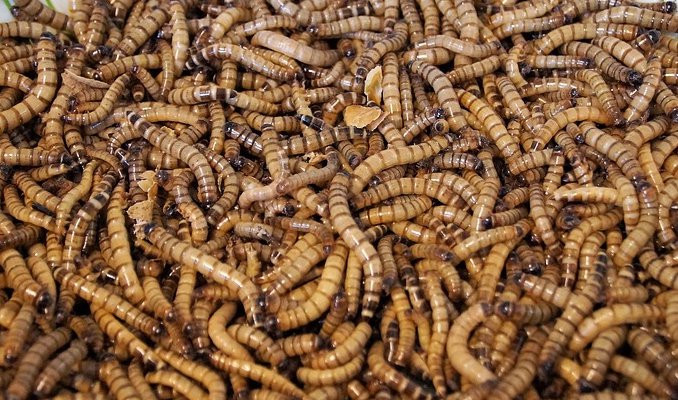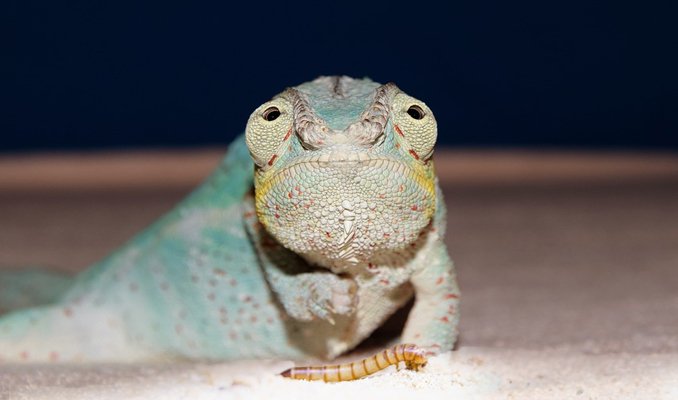Chameleons that are kept in captivity will mostly eat what their owner gives them. In captivity, insects are the most popular choice with crickets being their staple food since they are plentiful and packed with nutrition. However, feeding them just crickets won’t satisfy their daily nutrition requirements. Other food will also need to be given to them. There are many other foods available that you feed them and one, in particular, is the mealworms. Therefore, most pet owners will wonder if it’s safe to feed their pet chameleons.
So can chameleons eat mealworms? Chameleons are not picky eaters and will eat just about anything you give them. As for mealworms, all species of chameleons will eat them. Mealworms are packed with nutrition and vitamins that other insects don’t have. Feeding them along with their staple food of insects will help fulfill their daily supplements intake.
Can Chameleons Eat Mealworms
While mealworms aren’t one of the food that would be found in their natural habitat, mealworms make an excellent food supplement.
Like people, pet chameleons need the right balance of vitamins, minerals, protein, fat, and carbohydrates to thrive.
In the wild, they get an ample amount of vitamins and minerals through the insects they eat. These insects such as crickets and grasshoppers will feed on fruits and vegetables before it gets eaten by the chameleons.
On the other hand, in captivity, the insects they eat are usually bought at stores that are feeder insects. This means the insects aren’t fed the proper food to get all the nutrition. The insects are bred just to be sold as feeders. When it’s fed to the chameleons, the crickets will not have enough vitamins and minerals to meet the chameleon’s daily supplements intake.
Therefore, you’ll either have to sprinkle them with vitamin supplements or feed them other foods like mealworms.
Health Benefits For Chameleons Eating Mealworms
Omega-3 fatty acids – Helps improves bone and joint health, keeps the eyes healthy, and helps keeps the skin healthy.
B vitamins – For a chameleon, vitamin B helps with the breakdown of fats and proteins, which is important for metabolizing and energy production. B vitamins also keep the muscles, skin, hair, and eyes healthy.
Mealworms also have vitamins B5 and B12 which help aid in growth and development.
Proteins – The proteins found in mealworms help chameleons regulate their blood, build and repair muscles, and keep their skin healthy.
Fiber – Fiber in mealworms will help chameleons with the digestion of foods and prevent constipation.
Can Baby Chameleons Eat Mealworms
Baby chameleons can and should have mealworms as part of their daily diet. Since baby chameleons grow quickly, they need plenty of nutrition, especially protein to help them grow. Mealworms are loaded with proteins and other nutrients that can help support their growth. When mealworms combined with crickets, and green leafy vegetables fed to them daily, the baby chameleons will be healthy and strong when they grow up.
When feeding baby chameleons, always feed them live and healthy mealworms. Dead mealworms have fewer proteins and other nutrition than live mealworms will. In addition, dead mealworms could contain parasites and dangerous bacteria.
Freeze-dried or dried mealworms should be avoided when feeding baby chameleons. These types of mealworms don’t have the necessary nutrition that baby chameleons need. When the mealworms are freeze-dried, it loses nearly half of the nutrition. Therefore, feeding freeze-dried mealworms should not be fed to them unless you really need to. The only time you should feed them is when there are absolutely no other foods to feed them.
Baby chameleons should only be fed small mealworms that they can fit easily into their mouth. Medium and large-sized mealworms could choke the baby chameleons.
Can Chameleons Eat Dead Mealworms?
All chameleons regardless of their age will need part of their diet to be live. Baby and juvenile chameleons will need about 80% live protein in their diet, while adults require just 20% live protein in their diet.
Dead mealworms do not have as much nutritional value as live mealworms would. While they are alive, their body holds a large percentage of water. That water is would hold the vast majority of the nutrients in their bodies.
When the mealworms die, they will start to lose water, and along with the nutrients that are in there.
Chameleons can be fed dead mealworms, but you’ll need to be careful about it. It’s important to find out how they died in the first place. If the mealworms died due to sickness or had parasites, these could be passed down to the chameleons.
Therefore, if you’re unsure how the mealworms died, it’s best to throw them away.
The safer way to feed dead mealworms is to purchase properly prepared dried ones. However, you should only feed these types of food as an emergency supplement only. Feeding them dried mealworms regularly could cause them to become ill not getting enough nutrients each day.
Can Chameleons Eat Freeze-dried Mealworms
Chameleons can be fed freeze-dried mealworms, but only as emergency food. This meaning you have no live foods to feed them.
Freeze-dried mealworms usually don’t have high protein and Freeze-dried mealworms can be found at most local pet stores or online stores like Amazon.
Always make sure they are of the highest quality. Feeding dried mealworms to your pet chameleons could contain parasites and other dangerous pathogens. These can cause your chameleon to become sick and even die. Chameleons are good at hiding their illness and some owners will not notice anything wrong until it’s too late.
How Many Mealworms To Feed A Chameleon
For baby chameleons, they should be feed as many mealworms as they can eat. They need all the proteins and other nutrition they can get to help them grow. Baby chameleons grow very quickly and most species will reach their adult size by 8 months.
The size of the mealworms to feed baby chameleons should be the smallest size possible. As a general rule, the mealworms should never be larger than their eyes. Any size larger could cause the baby chameleons to choke.
For juvenile chameleons, they too should be fed as many mealworms as they can eat. At this age, they are still growing and need all the nutrition they can get.
Unlike baby chameleons, which you can feed without any limits, juvenile chameleons should be fed 3-4 small mealworms at a time. After they have eaten all the worms, you can add more to the cage for them to eat. When juvenile chameleons are full, they will not consume anymore.
For adult chameleons, they should be feed medium or large-sized mealworms. At this age, they can be fed 5-6 mealworms at a time. After they have finished eating all of the worms, you can add a couple more mealworms to their dish.
How To Feed Mealworms To Chameleons
Chameleons should never be fed strictly mealworms as their diet. When feeding mealworms to chameleons, they should be fed crickets and dark leafy greens as well. Also, make sure the mealworms are healthy and free of diseases and parasites.
When feeding chameleons, they should be fed mealworms according to their age. Baby and juvenile chameleons should be fed small-sized mealworms, while adult chameleons are fed with large-sized mealworms. In addition, the mealworms should be coated with multivitamins. Multivitamins help provide the additional nutrition that the mealworm alone can’t provide.
Along with mealworms, crickets should also be added when feeding them. Crickets too should be sprinkled with calcium. The calcium will help strengthen their bones as they grow.
On the second feeding, add a couple more mealworms and crickets along with dark green leafy plants to their dish. Make sure to mist the vegetables a bit to prevent the chameleons from being dehydrated.
For baby and juvenile chameleons, you should feed them as much as they can eat. You should continue to feed them until they are eating ¾ of their food in the first 30 minutes. At this time, any mealworms, crickets, vegetables, or any other foods should be removed from the cage.
For adult chameleons, they should only be fed 5-6 insects per feeding. After they have finished it, you can add a couple more to their dish. Feeding adult chameleons twice daily combining mealworms, crickets, and green leafy vegetables should be sufficient.
Related Questions
What are mealworms?
Mealworms are the larval form of the mealworm beetle, Tenebrio Molitor. This is a species of darkling beetle. In the larval form, they are about 2.5 cm in length, while the adults are between 1.25 and 1.8 cm.
Are mealworms and superworms the same?
Mealworms and superworms are from the same species of darkling beetle. Other than that, the only difference between the two is their size.
Mealworms are about 1.25 to 2.5 cm in length. Superworms, on the other hand, are 3.8 to 6.3 cm in length.
Besides the length, the superworms are much thicker and juicy looking. All of this equates to more proteins and other nutrition that they have.


